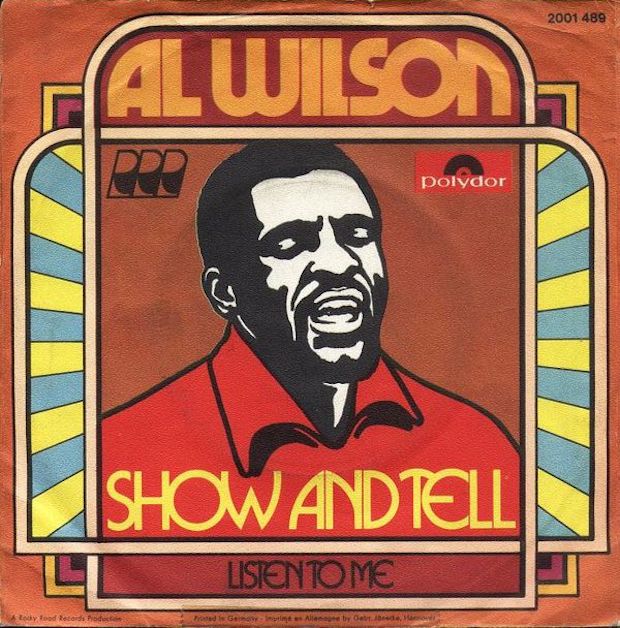In The Number Ones, I'm reviewing every single #1 single in the history of the Billboard Hot 100, starting with the chart's beginning, in 1958, and working my way up into the present.
Al Wilson - "Show And Tell"
HIT #1: January 19, 1974
STAYED AT #1: 1 week
The early '70s must've been a great time to be a veteran nightclub R&B singer. The Chi-Lites, the O'Jays, Billy Paul -- all these guys had been around since the doo-wop era, if not before. They'd been scraping along, playing gigs and recording singles wherever they could. And then suddenly, they were making the biggest hits of their lives. There's a reason for that.
In the early '70s, the sound of soul music changed. Production got thicker, lusher, more luxurious. Philadelphia International Records had found great success by slathering their R&B records with orchestral crushed-velvet splendor, and a lot of other people tried to rip off that sound. I have this theory that the sound required older voices. Those songs would've just evaporated if they'd been sung by teenagers. Instead, they needed craggy, weathered voices -- grown-up voices. And so that's what all those doo-wop veterans offered. They'd all been singing for long enough that their voices had rasp and grit, and that rasp and grit translated into churchy authority. Al Wilson's "Show And Tell" isn't a great song, but if it works, it works because his voice has that authority.
https://youtube.com/watch?v=ItgAlRuafaU
Wilson was 34 when he landed his sole #1 single. He'd grown up in Mississippi, singing gospel in the church and country outside of it, and he'd spent time in the Navy. When he got out, he moved to Los Angeles, where he sang in a few early-'60s groups and played drums in a few others. He also worked odd jobs -- delivering mail, washing dishes, cleaning offices. In 1966, Johnny Rivers, the "Poor Side Of Town" guy, signed Wilson to his Soul City label. "The Snake," a smoothly grimy single that Wilson recorded for Soul City in 1968, got as high as #27, and it became a cult favorite on the Northern Soul scene, the pre-rave phenomenon where British kids would take a bunch of speed and spend all night dancing to obscure R&B records. (Northern Soul is probably one of the top 10 subcultures I wish I could go back in time and experience in person.) But "The Snake" didn't make Wilson a star, and he more or less drifted back into obscurity afterward.
But Wilson kept singing and kept working the nightclub circuit. One night in 1973, Jerry Fuller came to see him. Fuller had written the #1 hit "Travelin' Man" for Ricky Nelson 12 years earlier,and he'd hung around since then as a freelance songwriter and producer. Fuller had started his own production company a couple of years earlier, and he liked what he heard from Wilson. Fuller had written a love ballad called "Show And Tell," and he'd produced a version of the song for the smoothed-out old-school crooner Johnny Mathis. (Mathis had gotten to #1 with the pre-Hot 100 1957 single "Chances Are," and he got there again more than two decades later. We'll see him again in this column.) The Johnny Mathis version of "Show And Tell" went nowhere, probably because it was a snore.
https://youtube.com/watch?v=SG-JXoX2610
Fuller offered to let Wilson hear the Johnny Mathis version of "Show And Tell," but Wilson decided to record his own version without listening to anyone else's take on the song. This was probably the right move. "Show And Tell" is a slight song, a basic love-jam in which a guy attempts to cheesily display all the different ways that he loves a woman: "These are the eyes that never knew how to smile till you came into my life / And these are the arms that long to lock you inside every day and every night." Johnny Mathis didn't do anything with those sentiments. Al Wilson did what he could.
Sugary pop ballads like "Show And Tell" were nothing new. The song could've come out in the '50s or the early '60s, when it would've had chintzy strings and bum-bum-bum backing vocals. The Al Wilson version had chintzy strings, too, but they were a different kind of chintzy strings. Fuller was smart enough to make Wilson's version of the song funkier than the one he'd done with Mathis. The Wilson version is a straight-up Philadelphia International bite, with horn-bursts and a slow-strut bassline and Fender Rhodes noodles and orchestral flourishes. It doesn't have the depth of those Gamble & Huff records, but if you're willing to spring for all the studio musicians, that's a tough sound to fuck up completely.
And Wilson sounds good on the song, giving a thoroughly professional soul-singer performance. He oscillates nicely between control and passion, letting his voice explode out on the chorus. He couldn't flex on "Show And Tell" the way he'd done on "The Snake," but he could work in occasional Al Green high notes or growly ad-libs. He can't save the mediocrity, but he can at least add some weight to it.
Wilson would make a few minor hits after "Show And Tell," but he'd never get near the top 10 again. He kept playing shows, living that nightclub-singer life. He died of kidney failure in 2008, when he was 68.
GRADE: 4/10
BONUS BEATS: Here's the 2007 Bone Thugs-N-Harmony/Kelly Rowland collaboration "So Crazy," which samples "Show And Tell":
(Rowland and Bone Thugs will both show up in this column eventually. Also, there's apparently a scene from a Malcolm In The Middle episode where Bryan Cranston dances naked to "Show And Tell," but I couldn't find video of it anywhere.)






